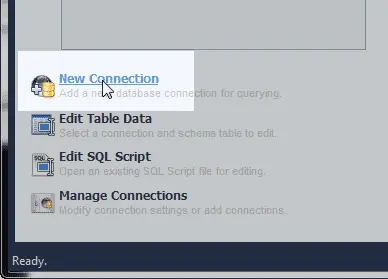

- #ADD SQL FILE TO MYSQL DATABASE WORKBENCH HOW TO#
- #ADD SQL FILE TO MYSQL DATABASE WORKBENCH VERIFICATION#
- #ADD SQL FILE TO MYSQL DATABASE WORKBENCH CODE#
If you want ALTER you'll have to (as far as I can tell) manually change the CREATEs to ALTERs. The wizard will take you further, but if you just want the script you can stop here.Ī word of caution: the scripts are generated with CREATE commands. Follow this answer to receive notifications. From the database home screen ( Figure A ), right-click a blank spot under the SCHEMAS pane and select Create Schema. How do I export a SQL file from MySQL workbenchHow do I export a database from MySQL workbenchHow d0 I export a MySQL schemaHow to Export the results of a. 1> create a new query tab 2> CREATE DATABASE databasename 3> USE databasename 4> open the filename.sql file and execute it ctrl + shift + enter 5> all the tables in the filename.sql are created. Open MySQL Workbench and connect to your database server. At this point you can Copy to Clipboard or Save to Text File. you can simply do it using mysql workbench.

Click on the SQL Editor tab and select your database from the SCHEMAS list in the Object Browser on the left.In Workbench Central (the default "Home" tab) connect to your MySQL instance, opening a SQL Editor tab.As with creating your database, you can create your tables either programmatically or via the GUI.How to generate SQL scripts for your database in Workbench
#ADD SQL FILE TO MYSQL DATABASE WORKBENCH CODE#
You can also add code that checks for the existence of any databases that already use that name.
#ADD SQL FILE TO MYSQL DATABASE WORKBENCH HOW TO#
This is as quick and easy as writing CREATE DATABASE VegeShop. In this video, I will share with you guys how to use MySQL Workbench Export a MySQL database to SQL Files in the following ways:- Export a Database to a Sing. sql file in MySQL Server by using MySQL Workbench.To f. You can tell when a database is the default database because its name is rendered in a bold typeface: Creating Databases ProgramaticallyĪs mentioned, you can also create your databases programmatically. How to import sql file to MySQL by using MySQL Workbench is step by step demo how you can import the.
#ADD SQL FILE TO MYSQL DATABASE WORKBENCH VERIFICATION#
You can set the new database as the default database by right-clicking on it and selecting Set as Default Schema: MySQL Workbench: SQL Editor: Severity: S3 (Non-critical) Version: OS: Windows: Assigned to: MySQL Verification Team: CPU Architecture: Any: View Add Comment Files Developer Edit Submission View Progress Log Contributions 14 Mar 13:03 Aditi Jadhav. You will now see your new database listed under the SCHEMAS tab on the left pane: Setting the Default Database You should see the following screen once the database has been created:.With these techniques, you can load data from other text file formats such as tab-delimited. We have shown you how to import CSV into MySQL table using LOAD DATA LOCAL and using MySQL Workbench. The file filter for the file open dialog window. MySQL workbench will display a dialog Apply SQL Script to Database, click Apply button to insert data into the table. This is the script that contains the data definition statements for the sakila database. Find and import the sakila-schema.sql file. Lastly, just choose the SQL file to import, and where to import it into. Open MySQL Workbench, select the models view from the sidebar in the home screen, click ( >) next to Models, and then click Reverse Engineer MySQL Create Script. SELECT FILE > SELECT DATABASE > START IMPORT. After connecting to your database, Server > Data Import. To run the statement (and create the database) click Apply: Add a connection to your database, then click on it. You are prompted to review the SQL statement that will be run to create the database.Enter the schema name (in this case, VegeShop) and the default collation (in this case, latin1 - default collation), then click the Apply button:.Click the icon for creating a new schema (you'll find this on the Workbench toolbar):.The database will now be created, and a message will display advising that the script was successful. Review the SQL statement and click Apply. Enter a schema name (database name) and its default collation and click Apply. In the following example, we create a new database called "VegeShop". To create a database in the MySQL Workbench GUI: Click the new schema button on the MySQL Workbench toolbar. You can also create a database programmatically but here's how to do it via the GUI. You can use the MySQL Workbench GUI to create a database.


 0 kommentar(er)
0 kommentar(er)
